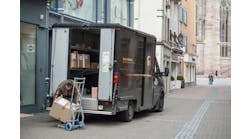As commercial and home deliveries are on the rise, the Southern California Association of Governments (SCAG) conducted a study to provide solutions to the logistical challenges and community impacts that result from this trend.
In the study, Last-Mile Freight, that group unveiled a series of strategies to address these challenges.
Nationwide, parcel deliveries are expected to double by 2025, which is creating serious challenges with regard to efficiencies and delays, street congestion and public safety.
"While goods are often shipped long distances to reach their destination, the final segment of a shipment – the “last mile” – tends to be the most complicated as delivery vehicles compete for space with cars, transit vehicles, bicycles and pedestrians. According to the study, last-mile costs can exceed 50% of the total delivery.
And while the data collection and analysis for the Last-Mile Freight Study was conducted in 2018, SCAG notes that many of the trends accelerated after the onset of COVID-19, with some product delivery categories showing exponential increases year over year.
“Deliveries have become an essential part of our everyday lives. Throughout our region and across the country, it’s critical that we develop solutions and strategies to reduce costs and delays, ensure safety and make deliveries more efficient while reducing impacts to air quality in local communities,” said SCAG President Rex Richardson.
The study area was within the City of Los Angeles, though the methodology and findings could apply just about anywhere. Among the major recommendations:
- Integrate last-mile freight issues into a goods movement forum.
- Develop regional strategies for off-peak deliveries.
- Update building and zoning codes to require loading space.
- Convert on-street parking to loading areas where ample off-street parking is available.
- Develop commercial-only alleys.
- Restrict deliveries on certain streets.
- Consider establishing delivery consolidation centers in underutilized parking lots.
- Incentivize the use of clean-air vehicles for deliveries.
The study points to Southern California’s role as a global logistics and supply-chain hub and notes the continued expansion of e-commerce fulfillment centers in Los Angeles County and the Inland Empire. SCAG has previously reported that one-third of all jobs and economic activity in the six counties are connected – directly or indirectly – to goods movement.
“Freight shipments and deliveries are a lifeblood for our region. Harnessing the potential of emerging technology will help us reduce the environmental and traffic burdens of goods movement even as productivity grows,” said Kome Ajise, SCAG Executive Director.



